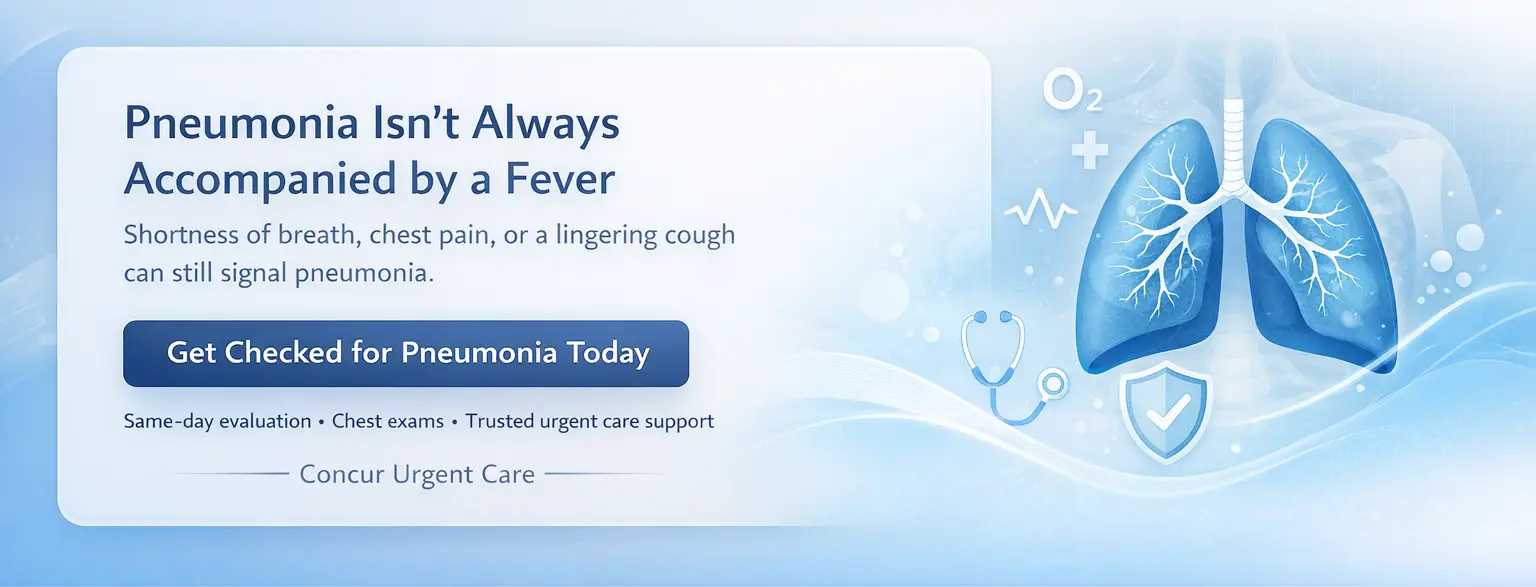Pneumonia, an infection of the lungs, can range from mild to life-threatening. While fever is often associated with it, it’s not always present. This comprehensive guide from Concur Urgent Care delves into the question, “Can you have pneumonia without a fever?” It explains why this can happen, lists the symptoms to watch for, and covers diverse aspects like diagnosis, treatment, and most importantly, when to seek care. Remember, our team at Concur Urgent Care is here to support you, providing the care and guidance you need during this challenging time.
Pneumonia occurs when germs like fungi, bacteria, and viruses inflame the air sacs (alveoli) in one or both lungs, causing them to fill with fluid or pus. Typical signs include cough, shortness of breath, chest pain, and often fever, but not always. This post will cover the symptoms of pneumonia with and without fever, the types, how it spreads, how clinicians diagnose it, treatment options including antibiotics, and practical recovery tips.
What is Pneumonia?
In simple terms, pneumonia is an infection of the lungs caused by bacteria, viruses, including influenza and certain coronaviruses, or, less commonly, fungi. It can be categorized by cause (bacterial, viral, fungal) and by clinical pattern. The exact treatment and prognosis depend on the cause, the patient’s age, underlying health conditions, and risk factors such as smoking, chronic lung diseases, and weakened immune systems.
Can You Have Pneumonia Without Fever?
Can You Have Pneumonia Without Fever? The short answer is yes, fever is common with pneumonia, especially with many typical bacterial pneumonias, but it is not universal. Older adults, very young children, people with weakened immune systems, and those with milder forms like walking pneumonia may not mount a noticeable fever, or they may have only a low-grade fever. It’s important to remember that clinicians consider the whole clinical picture, including cough, breathlessness, physical exam findings, and oxygen level, not fever alone. Understanding these symptoms can help you be proactive about your health and treatment.
Common Symptoms of Pneumonia
When fever is absent, other symptoms help prove diagnosis:
- Rapid breathing or shortness of breath, particularly with exertion
- Fatigue and weakness
- Persistent cough, dry or productive cough, may produce green/yellow or rusty sputum
- Chest pain that worsens with deeper breaths or coughing
- Runny nose, sore throat, or other respiratory symptoms
- Chills, sweating, or low-grade fever
These are classic pneumonia symptoms and signs of pneumonia, and many patients describe what pneumonia feels like as a deep, consistent cough, breathlessness, and chest tightness. When experiencing these symptoms, seeking medical care at Concur Urgent Care or a similar facility is essential. Remember, a normal temperature does not rule out disease, and early diagnosis and treatment can significantly improve outcomes.
Walking Pneumonia: A Milder and Fever-Free Form
Walking pneumonia, also known as atypical bacterial pneumonia, is a milder form of pneumonia that is usually caused by a bacterial infection, specifically a type of bacteria called Mycoplasma pneumoniae. Its symptoms come on gradually and can resemble a bad cold, with a persistent cough, mild shortness of breath, sore throat, fatigue, and sometimes mild or no fever. Walking pneumonia symptoms in adults often last several weeks and can cause a lingering cough.
Is Pneumonia Contagious?
Is pneumonia contagious? It depends on the cause. Viral and bacterial pneumonias often spread from person to person through respiratory droplets, such as coughing, sneezing, and close contact. Some organisms, such as Mycoplasma, spread more slowly and can have a more extended incubation period; others, including pneumococcus, have shorter incubation periods. Good hygiene, staying home when sick, and appropriate isolation can reduce the transmission. Your responsible actions can help protect those around you, significantly preventing the spread of pneumonia.
Diagnosing Pneumonia Without Classic Symptoms
Since fever is absent, clinicians use multiple tools to diagnose Pneumonia, including the following.
- History & Physical Exam- Listening for crackles, decreased breath sounds, or wheeze
- Chest X-ray- Often the key test to visualize lung involvement
- Pulse Oximetry- To measure oxygen saturation
- Blood Oests/Sputum Cultures- To look for infection and identify bacterial causes when indicated
- Other Tests (PCR, Antigen Tests)- May be used for specific pathogens
A normal temperature does not rule it out; if lung findings, oxygen level, or X-ray suggest pneumonia, treatment may be started. If you or a loved one has a cough and breathlessness, seek prompt evaluation.
Pneumonia Treatment: With and Without Antibiotics
Pneumonia treatment depends on the cause:
- Antibiotics for Bacterial Pneumonia- These are recommended when bacterial infection is suspected or confirmed. Common outpatient antibiotics are chosen based on age, allergies, and local resistance patterns.
- Antivirals- Used for some viral causes when specific agents exist, for example, influenza antivirals.
- Supportive Care- Rest, fluids, fever control (if present), cough management, and oxygen therapy for low oxygen levels.
- Hospital Care- Needed for severe disease, hypoxia, or complications.
Can You Recover From Pneumonia Without Antibiotics?
- If pneumonia is viral, antibiotics won’t help, and recovery may occur with supportive care.
- For bacterial pneumonia, antibiotics are usually necessary to prevent progression. Whether antibiotics are needed is a clinical decision based on diagnosis and risk factors. Discuss this with your clinician.
When to See A Doctor?
You must seek immediate medical attention if you notice anything from the following.
- Chest pain that is persistent or severe for a prolonged period
- Worsening shortness of breath or trouble breathing
- High or persistent fever or a fever that returns after improvement
- Symptoms that worsen or fail to improve after a few days of home care
- Facing difficulty in waking, confusion, or a sudden change in mental status, especially in older adults
At Concur Urgent Care, we quickly evaluate the symptoms of chest infection using a pulse oximeter, exam, or a chest X-ray, or referral for further care if required. If you suspect pneumonia, even if you don’t have a fever, getting checked as soon as possible is safer. Early diagnosis and adequate care reduce complications.
FAQ
Q. Can you have pneumonia without a fever?
A: Yes, you can have pneumonia without a fever, especially in older adults or those with walking pneumonia, where symptoms appear mild or fever may be absent.
Q. What are the main symptoms of pneumonia?
A: Persistent cough, shortness of breath, fatigue, chest pain, and sometimes confusion or low-grade fever are common pneumonia symptoms.
Q. Is walking pneumonia contagious?
A: Yes, walking pneumonia caused by Mycoplasma bacteria can spread through droplets from coughing or sneezing.
Q. When should I visit Concur Urgent Care for pneumonia symptoms?
A: Visit Concur Urgent Care if you have chest pain, difficulty breathing, or a cough that isn’t improving, even if there’s no fever.
Q. How long does pneumonia recovery take with Concur Urgent Care’s guidance?
A: With proper care from Concur Urgent Care, mild pneumonia may resolve in 1–2 weeks, but full recovery can take longer in severe cases.


